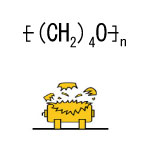| Case Name |
Damage to a tank roof caused due to sticking of a breather valve during transfer of raw material |
| Pictograph |

|
| Date |
January 29, 1998 |
| Place |
Yokkaichi, Mie, Japan |
| Location |
Chemical factory |
| Overview |
During transferring raw material to a storage tank, the breather valve stuck. Therefore, vapor in the tank could not escape, and the tank roof was damaged by the pressure increase. The defect in periodic checking and cleaning is considered to be the cause. The hazard of a valve sticking due to the contents in the tank might have been overlooked. |
| Incident |
A tank roof was damaged when raw material of synthetic fibers polytetrahydrofuran was transferred to a raw material storage tank. |
| Processing |
Storage |
| Substance |
Polytetrahydrofuran, Fig2 |
| Type of Accident |
Burst |
| Sequence |
Transfer of polytetrahydrofuran started to a raw-material storage tank.
An explosive sound was heard after a while. The tank roof was lifted up. |
| Cause |
A breather valve stuck. An atmospheric pressure tank is destroyed by a slight pressure difference between inside and outside of the tank. Therefore, a special valve (a breather valve) which breathes by about scores mmAq was prepared. Due to the contents of the tank, the valve seat of a breather valve stuck and did not operate. For this reason, gas could not escape on receiving, and the weakest joint between the tank roof and the side wall ruptured.
Breather valve; A valve which breathes. It is installed in an atmospheric pressure tank, discharges or intakes gas with a slight increase or decrease in the pressure in the tank. |
| Response |
The contents were transferred to another tank. |
| Countermeasures |
Checking and cleaning of the breather valve are carried out properly. |
| Knowledge Comment |
Resisting pressure of a general liquid storage tank is almost zero. A tank might be destroyed by a temperature change, not only by receiving or sending material. A breather valve is indispensable for a tank to breathe, and management for correct operation is required. Probably, multiple management of the valve will be required if there is a strong possibility of the valve sticking due to the content liquid.
Sometimes, it may be desirable to install a pressure sensor in a tank, also a safety valve and a rupture disk are required depending on the case. |
| Background |
There seems to have been a mistake in checking and cleaning directions for the breather valve. In other words, it is assumed that tank management was inadequate. The quantity of vapor of a stored liquid contained in the vapor layer of the tank corresponds to the vapor pressure at the tank temperature. It is the same even if a nitrogen blanket is used. A polymerization reaction occurs under the partial pressure or the concentration. If a liquefied substance is sticky, a breather valve will stick naturally. |
| Incidental Discussion |
A breather valve mounted at a corn roof tank begins to open at +25mmAq and -25mmAq, and usually has a design discharge capability at +38mmAq and intake capacity at -38mmAq. The design flow rate of discharge or intake is calculated from the size of the tank, the flow rate for receiving and shipping, and physical properties. Naturally, a sudden temperature change is also taken into consideration. |
| Reason for Adding to DB |
Example of damage to a tank caused due to sticking of a breather valve |
| Scenario |
| Primary Scenario
|
Poor Value Perception, Poor Safety Awareness, Inadequate Safety Measure, Carelessness, Insufficient Precaution, Inadequate Handling, Organizational Problems, Poor Management, Looseness of Organization, Usage, Maintenance/Repair, No Periodic Inspection, Malfunction, Poor Hardware, Stick, Failure, Large-Scale Damage, Tnak Rupture, Loss to Organization, Economic Loss, A Tank Damaged
|
|
| Sources |
High Pressure Gas Safety Inst. of Japan, The high-pressure gas protection overview 1999 edition, p.146 (2000).
The Res. Inst. of Industrial Safety material. (closed)
|
| Physical Damage |
Lifting up roof top. |
| Multimedia Files |
Fig2.Chemical formula
|
| Field |
Chemicals and Plants
|
| Author |
ITAGAKI, Haruhiko (Japan National Institute of Occupational Safety and Health)
TAMURA, Masamitsu (Center for Risk Management and Safety Sciences, Yokohama National University)
|
|